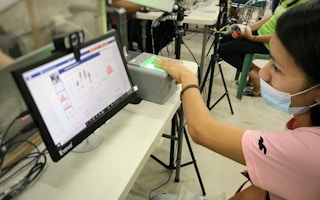Around the world, high inflation, slow economic growth, and food shortages are hurting the poor the most. Coming on top of the unequal effects of the Covid-19 pandemic, today’s multiple crises have already caused dramatic reversals in development and led to a substantial increase in global poverty.
On the positive side, the Covid-19 crisis spurred unprecedented change, especially in industries with a large digital component. This digital revolution has catalysed increases in access to and use of financial services in developing economies, transforming how people make and receive payments, borrow, and save.
These changes are strikingly evident in the latest edition of the Global Findex database, compiled from a survey of more than 125,000 adults in 123 economies, covering use of financial services throughout 2021.
The survey found that 71 per cent of adults in developing economies now have a formal financial account – whether with a bank, another regulated institution such as a credit union or microfinance lender, or a mobile money service provider – compared to 42 per cent when the first edition of the database was published a decade ago.
In addition, the difference in the share of men and women in developing economies who own an account has fallen for the first time, from nine percentage points to six.
“
The digital revolution also serves as a powerful anti-corruption tool, because it helps to increase transparency as money flows from a government’s budget to public agencies to citizens.
This digital transformation makes it easier, cheaper, and safer for people to receive wages from employers, send remittances to family members, and pay for goods and services. Mobile money accounts can better handle high-volume, small-denomination transactions, which help users to access financial services and save in order to cope better with crises. Individual accounts also give women more privacy, security, and control over their money.
The share of adults in developing economies who make or receive digital payments grew from 35 per cent in 2014 to 57 per cent in 2021. In Sub-Saharan Africa, 39 per cent of mobile money account holders now use their accounts to save. And more than one-third of people in low- and middle-income countries who paid a utility bill from an account did so for the first time after the start of the Covid-19 pandemic.
Importantly, the digital revolution also serves as a powerful anti-corruption tool, because it helps to increase transparency as money flows from a government’s budget to public agencies to citizens. Government social programmes can now reduce delays and leakage by channeling transfers directly to their beneficiaries’ mobile phones. Millions of people in developing countries received payments in this way during the pandemic, helping to cushion the impact of Covid-19 on livelihoods.
Building on these encouraging trends is crucial, especially given the current economic headwinds. Expanding people’s access to finance, reducing the cost of digital transactions, and channeling wage payments and social transfers through financial accounts will be vital to mitigating development setbacks resulting from the ongoing turbulence.
Governments and the private sector can help further this transformation in several critical areas. First, they need to create a favourable operating and policy environment. For example, enabling the interoperability of systems allows for payments across different types of financial institutions and between mobile money service providers.
Improving access to finance depends much more on the mobile-phone system than on the physical banking system. Cheap and functional mobile phones and affordable internet access are prerequisites for expanding digital finance. Consumer protections and stable regulations are also needed to foster safe and fair practices that bolster trust in the financial system.
Establishing digital-identification systems also is essential, because lack of verifiable identity is one of the main reasons why some adults remain excluded from financial services. We know from the experiences of countries such as India and the Philippines that government identification programs and financial-inclusion programmes can work in tandem to equip hard-to-reach populations with official identification documents and financial accounts. India, for example, has pioneered a successful biometric universal ID system that pays due attention to safety and privacy.
Another high priority should be to promote the digitalisation of payments. The Global Findex data for 2021 show that 865 million account owners in developing economies opened their first account at a bank or similar institution in order to receive money from the government.
This helped households directly and also helped build the digital financial ecosystem, because people who received payments into an account were more likely to use their account to make payments and access other services. Digital payments by governments thus serve as a foundation for assembling credible social registers and identifying gaps and overlaps.
As digital payments become more widespread and less costly, many private businesses will be able to pay their workers and suppliers electronically – and should. The digital revolution offers a chance to increase formal-sector employment without making compliance excessively burdensome. At a time of tighter government budget constraints, digital payments can help broaden the revenue base by reducing tax avoidance and evasion.
Finally, policymakers will need to make additional efforts to include underserved groups. The gender gap in financial access has narrowed, but it still exists. Women, along with the poor, are more likely to lack a form of personal identification or a mobile phone, to live far from a bank branch, and to need support to open and use a financial account. Financial-education programs, especially those that involve peer-to-peer learning (such as through women’s self-help groups) are essential as well.
The World Bank is firmly committed to expanding financial inclusion through digitalisation. We will continue to support countries as they enhance mobile-phone networks, rework regulations to foster access to finance, adopt e-government platforms, and modernise social-protection systems. For the many millions of people who still lack an account, we need to redouble our efforts and find creative ways to connect them to the financial system, build economic resilience, and reap the benefits of inclusion.
© Project Syndicate 1995–2022









